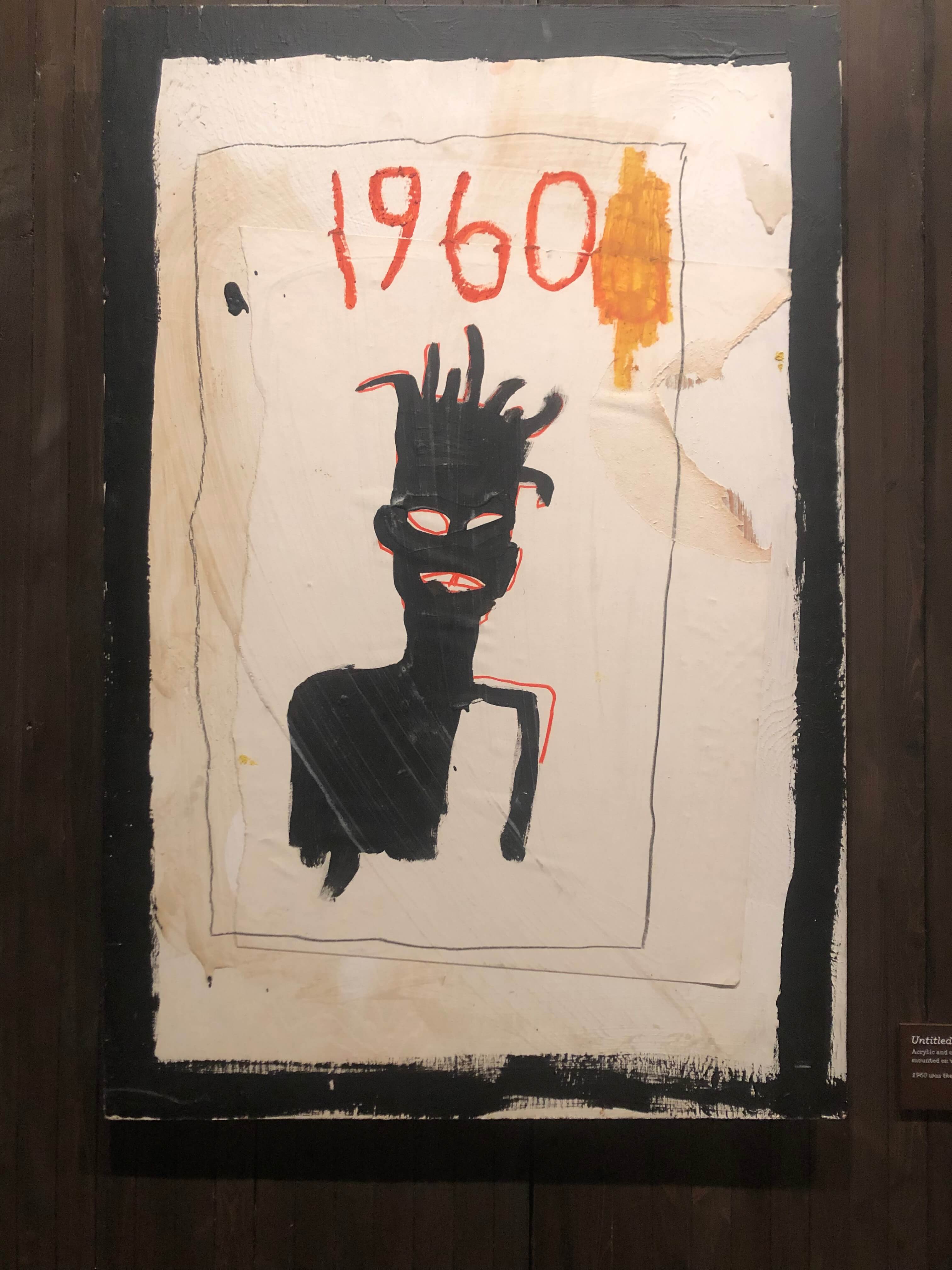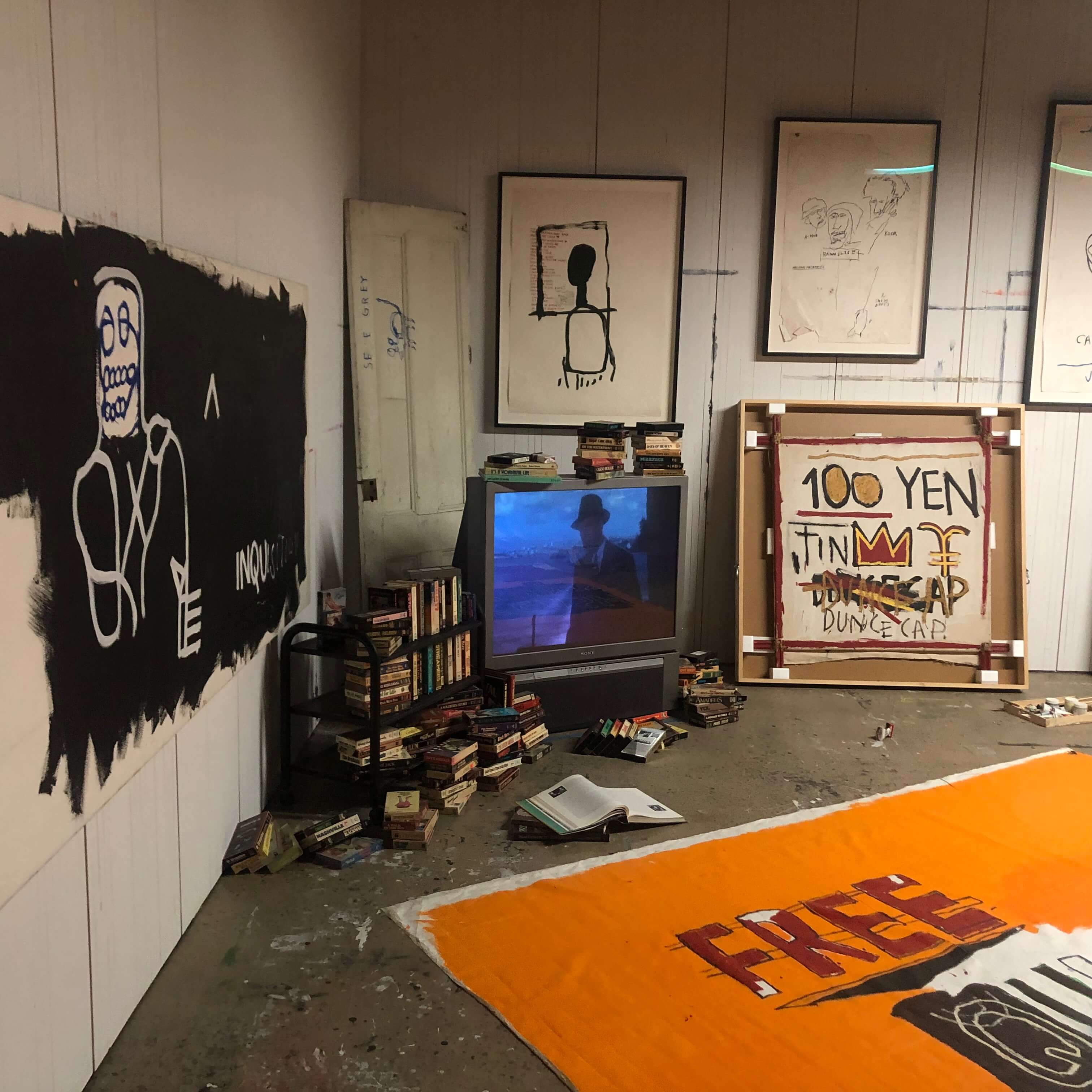The King Pleasure show organized by his family, an intimate portrait of a local artist who took the downtown New York art scene by storm. Then he took his artwork across the globe.
Jean-Michel Basquiat was born right here in Park Slope Brooklyn.
To Matilde and Gerard Basquiat.
Later they settled in Boerum Hill.
His mother noticed his interest in art and nurtured it by taking him to The Met and The Brooklyn Museum of Art.
Where he viewed Picasso’s works including Guernica.
Which was highly influential to Jean- Michel.
I discovered Basquiat as a 19 year old. I was at the San Antonio Museum of Art, I was looking through the books on their shelves in the shop.
At the bottom on one shelf there was a face looking up at me. A book laying there a bit beat up.
A line drawing of a face with explosive eyes, a vibration, a rhythm, and a stick-like halo. I grabbed it. Who is this? This was my introduction to Jean-Michel Basquiat. The book was The Whitney Museum catalog by James Marshall.
A trampled book on a sale shelf – it was mine now!
His work was different.
Modern.
He combined drawing and painting simultaneously.
This was his trick!
His skill.
His contribution.
An ability to combine line drawing and brushed paint on one canvas. Andy Warhol and others tried this in moments especially in early pop paintings. Jasper Johns had done this to some degree with his marks and encaustic crust paintings and prints having a drawn element. Jim Dine also uses drawing in his paintings. Larry Rivers too. . It was a part of Pop art until the hard-edged print images took over.
Twombly made drawing into painting.
No doubt Jean-Michel knew his work.
There’s a Dubuffet relationship too.
But Jean has his own personality.
Easily seen in his artwork.
His art is a direct line to his thoughts, passions, fears, influences, and discoveries.
This is why we love his work.
Immediacy.
Poetry.
Collision of ideas, references, and imagery.
Editing.
Jean-Michel puts the discovery there for you to see.
Most painters cover their tracks.
Re-working.
Perfecting the image.
He grabs chance opportunities he embraces the moment in his painting.
If it didn’t work.
Just paint over it.
Until it does.
Put down the colors and images.
Take them away.
Omit this.
Add that.
It’s a mobile – fluid – attack on the canvas or whatever surface to be painted.
Like graffiti.
Layering.
In his approach.
He absorbed plenty of this overpainting style walking down the street or riding a train.
The whole of downtown was covered in paint.
He reverberated that style into a style of his own.
A way of painting.
A painter almost can’t use an oil stick anymore.
Basquiat’s Trademark.
TM.
He took it.
He capitalized on his talent.
His vision and ability.
Others helped him grow.
Diego Cortez organized the 1980 Times Square art show putting Basquiat on the map.
A larger map.
Already known downtown now he was getting offers for shows.
Annika Nosei.
Bruno Bishofberger.
Mary Boone.
Fast forward to today.
Basquiat – King Pleasure is the show.
King Pleasure is the title of a Jazz Record. Jean referenced in several works.
This exhibition draws together works from the estate of the artist and highlights his roots, early work, local shows like the Fun Gallery in the East Village. Plus major works from later shows in larger galleries.
Basquiat’s monumental scale canvases made for the Palladium nightclub are presented here in a surprising recreations of the Palladium.
Basquiat’s giant 20’x20’ dragon-head painting dominates.
The opposite wall is a linear canvas that must be over 40 feet long.
An entire roll of canvas.
“Nu-Nile” this painting is an important masterpiece.
It suggests a new world view.
It stresses the importance of the African – origin of humanity.
A large Notary stamp notarizes it for us – 1985.
It’s an epic work.
It’s stark red black and white – like type in a newspaper.
He punched out images on this long scroll of a work.
A Batman like pow! With two silhouettes. There are two views of the Earth. One seems to be under attack by the paint itself. The other shows images of Petrol and human power struggles. The struggle of life on this planet.
Unlike many works the text is nearly omitted
On this canvas he speaks in images nearly exclusively.
It’s a fascinating painting.
A journey.
It’s like Kerouac, who wrote “On The Road” on a long continuous roll of paper.
Jean-Michel knew Kerouac’s friend William S. Burroughs. Who’s bunker apartment was just blocks from his Great Jones Street studio.
A glimpse into Basquiat’s studio. Recreated here in the show. With his own things.
His television, video tapes, objects he collected, brushes, paint, and work spread around the re-created studio space.
It’s powerful.
I was surprised how effective this was.
It could have been a gimmick.
But it evokes his personal space.
His studio.
His way of working.
It evokes Basquiat the person.
The artist.
The local man whose paintings have become so popular.
World famous.
A King from Kings County!
Makes sense.
Boom for real!
Blake Sandberg is a musician, painter and skateboarder who lives in Sunset Park.













